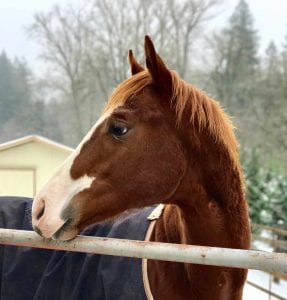If you own a splashy solid Paint, you know the frustration: your horse has all the chrome promised by his colorful lineage, but not quite in the right places—maybe his bald face is just an inch shy of crossing behind his eye or his high stocking doesn’t reach far enough above the center of his hock. Despite having all the trappings of a Paint to the casual observer, your horse is denoted a solid Paint-bred.
Sound familiar? Then take heed: a new registration rule voted into effect by directors at the 2017 APHA Convention might be your horse’s ticket to the Regular Registry.
An addition to Rule RG-070, which describes APHA’s color requirements for registry designation, the new rule provides an option for a horse to advance into the Regular Registry even if it doesn’t have two inches of solid white hair in the “designated zone.” To qualify under the new RG-070.E., horses must meet three criteria:
• Horse’s sire and dam must be APHA registered (Regular or Solid Paint-Bred)
• Horse must have a “Paint characteristic”
◦ Characteristics: White leg markings above the knees or hocks, blue eyes, apron face or bald face, white on the jaw or lower lip, blue zone around a natural Paint marking, two-color mane (one color must be white), dark spots or freckles in white hair on the face or legs, white areas in the non-visible zone, or a contrasting area of another color in the non-visible zone (for a predominantly white horse)
◦ See rulebook for details: RG-070.G
• Horse must carry a Paint pattern gene, confirmed through APHA genetic testing from an APHA-approved lab
◦ Paint pattern genes: Tobiano; Frame Overo; Sabino 1; Splash White 1, 2 or 3; Dominant White 5, 10 or 20
◦ Approved labs: University of California–Davis, Etalon Diagnostics
This rule will help “close-call” horses—those who look like Paints through their characteristics, but lack placement of their white spots in exactly the right locations—earn their rightful spot in the Regular Registry.
“The reference points used by APHA are man-made guidelines, and we often see horses that just barely miss the mark in terms of rulebook requirements for the two inches of white hair that would give them Regular Registry status,” APHA Executive Director Billy Smith said. “This rule will help reduce risk for breeders crossing Paints to Paints by allowing horses that meet all three guidelines into the Regular Registry. And because they carry a Paint pattern gene, these horses still have the potential to pass that gene on to future generations, too.”
APHA’s board of directors voted to approve the rule at the 2017 APHA Convention, and they also voted for early implementation. This rule goes into effect April 3, 2017.
Getting Started
If your solid Paint has two APHA-registered parents and a Paint characteristic, it could be worth your while to test for Paint pattern genes. Order your UC-Davis Color & Pattern Panel ($125) by completing the DNA Order Form and emailing it to APHA, or order the comprehensive color/pattern/health panel directly through the Etalon website ($139 option). APHA tests include official recording of results.
This rule is retroactive, meaning if your solid Paint-bred fits those three requirements, he or she can be advanced to the Regular Registry through a status change. Simply complete the “Request for Corrected Certificate” form and return it to APHA with your original registration certificate, photos of the qualifying characteristic, copy of your APHA genetic testing results on official lab letterhead, and the $75 status change fee (member rate).
If your foal is being registered, include extra photos of the characteristic at the time of registration along with the DNA order form.
Real Possibilities
 Solid Paint-bred owners like Brittany Sanders are excited about the possibilities that lay ahead. Brittany’s gelding Johnny Zipper—a 2016 chestnut gelding by the tobiano John Simon and out of the solid mare Strapless—just missed having Regular Registry-eligible color, but his wide blaze and blue zone indicate the presence of pattern-gene potential.
Solid Paint-bred owners like Brittany Sanders are excited about the possibilities that lay ahead. Brittany’s gelding Johnny Zipper—a 2016 chestnut gelding by the tobiano John Simon and out of the solid mare Strapless—just missed having Regular Registry-eligible color, but his wide blaze and blue zone indicate the presence of pattern-gene potential.
“When Johnny Zipper was born without the qualifying amount, I was definitely disappointed—I think I submitted photos to APHA three different times before I gave up,” she said. “When I got the test results back that he carried one copy of the W20 gene, I was thrilled!
“This rule change means a lot to me personally because I can continue to breed my mare to APHA stallions and have some peace of mind in knowing that if they don’t quite make the cut with qualifying white, there is still a chance they can obtain Regular Registry papers. This is a huge step in the right direction.”
Got questions? Email: [email protected].









